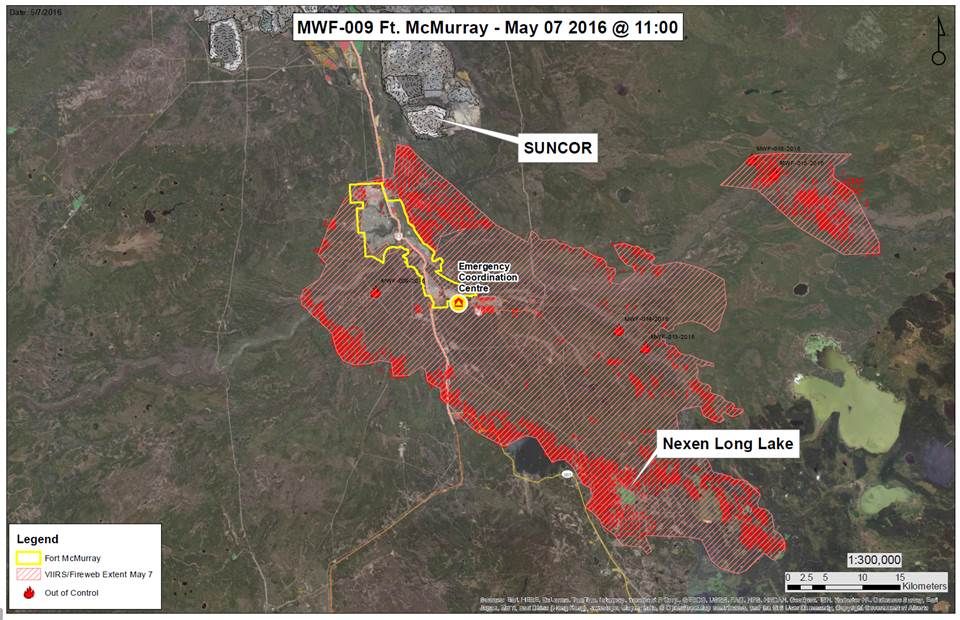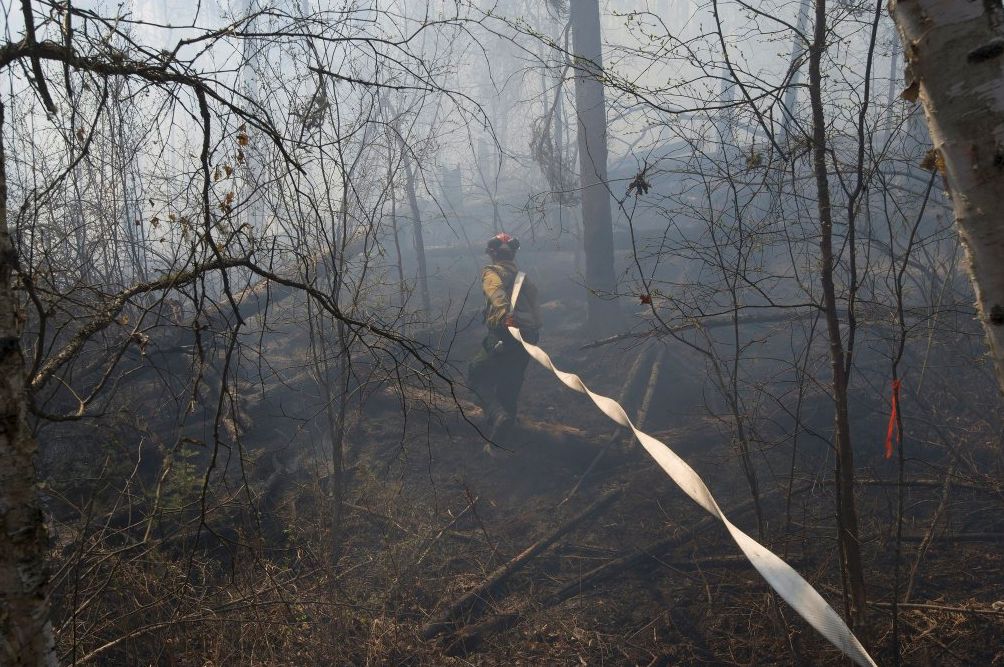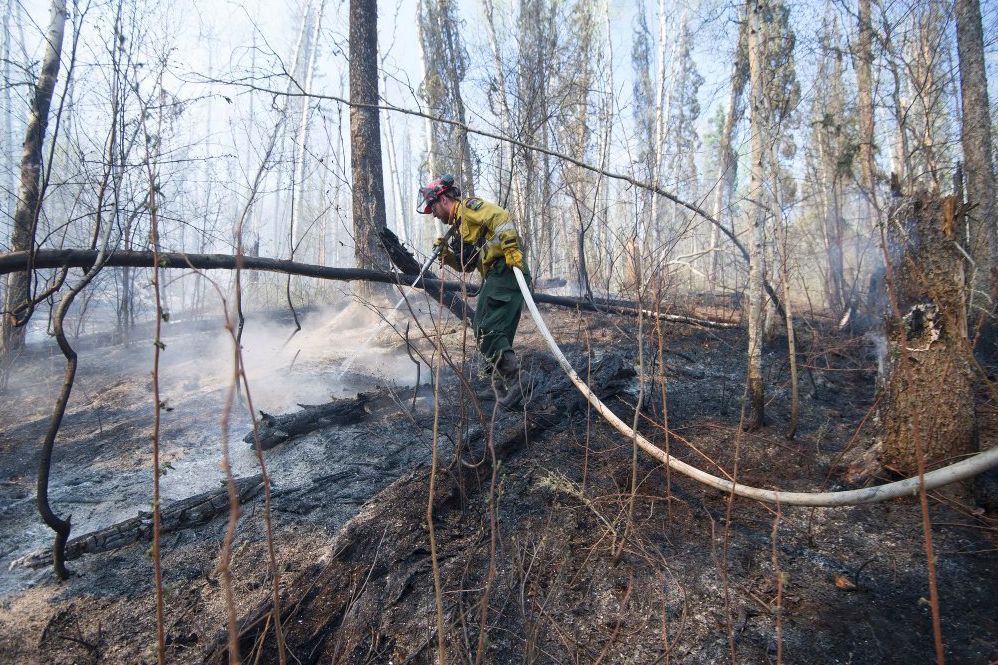EDITOR’S NOTE: This story will be updated throughout Sunday with the latest information.

EDMONTON- The provincial response to the disastrous Fort McMurray wildfire has now moved into “phase two” according to Scott Long of Alberta Emergency Management.
At a press conference early Sunday afternoon, Long said the first phase of responding to the emergency involved the preservation of life and protection of infrastructure and that while those efforts continue, a more advanced damage assessment will now begin and work will accelerate to make plans for re-entry although a timeline is still not available for when residents can return.
“Based on lessons learned that we have learned from Slave Lake and from High River, we have teams with an immense amount of experience in doing this and those folks are re-enforcing the Fort McMurray re-entry planning so that we can do it as smoothly and as effectively and as efficiently as possible and get people back to their homes quickly,” Long said. “If we don’t have a hospital and we don’t have a water treatment plant, that’s going to be a whole lot longer. We have a hospital, we have a water treatment plant, now we just need to get in there and see damage, determine how long and then develop that timeline.”
On Sunday, Premier Rachel Notley said she was planning to return to Fort McMurray on Monday to tour the city with Fort McMurray’s mayor Melissa Blake.
“It’s too early to speculate on the extent and the nature of the damage,” Notley said. “You can walk by a building – it looks like it’s still standing – then you go and you discover that there has been damage to it.”
“Conversely, something can look like it’s right next to something that has burned down and it’s completely functional.”
Notley also said about 250 gas and electrical workers from ATCO were currently in Fort McMurray working to restore the grid where power had been lost.
Public Safety Minister Ralph Goodale also addressed the media Sunday afternoon at a separate press conference in Edmonton, marking the first time a federal cabinet has been in Alberta to speak on the disaster.
Goodale said emergency funding will come through a cost-sharing formula with the province and that the”government of Canada will be there every step of the way.”
“We will be there in a consistent way for as long as it takes to do this right,” Goodale said.
Fort McMurray Wildfire Status
A provincial state of emergency remained in effect in the Fort McMurray area Sunday as officials said the disastrous wildfire was still burning out of control. However, they said the blaze been held at 161,000 hectares. Earlier, officials had said they were prepared for the possibility of the fire growing to over 200,000 hectares in size by Saturday night. For reference, the city of Edmonton is about 68,000 hectares in size.
Watch below: Alberta Premier Rachel Notley gives an update on the progress of the Fort McMurray wild fire stating that it’s heading east closer to the Saskatchewan border.

READ MORE: Saskatchewan prepares for wildfire to cross Alberta border
On Sunday, Alberta wildfire manager Chad Morrison said cooler weather, which is expected to last the next few days, helped keep the fire from growing to 200,000 hectares. While officials with the Rural Municipality of Wood Buffalo said the area received some precipitation Sunday, it was brief. Officials have said on multiple occasions that prolonged or heavy precipitation will be needed to really help slow the enormous blaze or else it could take months to be extinguished.
“We could see some growth if we get another week or two of hot and dry weather,” Morrison said. “We could expect to see some growth in that far, far, far eastern sides here, but again, that’s away from the communities and we still have a lot of work in front of us – especially in those forested areas.”
He also said an ongoing investigation continued into what actually sparked the fire.
Watch below: A look at the Fort McMurray firefight from the air

The premier also updated the wildfire situation in Anzac, a community where evacuees had previously sought refuge before it was also evacuated. On Sunday, Notley said several buildings had been lost in Anzac but that overall, firefighters had been able to protect it.
Long said more Fort McMurray houses were damaged by hot spots on Saturday.
Officials said the fire is now moving east and there is still the potential of it crossing the border into Saskatchewan, where smoke from the Fort McMurray wildfire has already been drifting over.
READ MORE: Where Fort McMurray fire evacuees can get help and information
Wildfire impact on Alberta oilsands
- ‘Blue Sky City’ unveiled as the new brand for the city of Calgary
- Southeast Calgary residents frustrated after strip mall parking lot potholes damage vehicles
- City buys back land after former Ernest Manning High School site sits empty
- ‘It is the love’: Wally the injured stray dog gets new ‘leash’ on life
Morrison said as of early Sunday morning, the wildfire hasn’t reached the Syncrude or Suncor oil facilities. On Saturday, the fire had been expected to spread in a northeast direction and to reach the edge of the Suncor oilsands site. He said a Nexen facility is believed to have suffered minor damage but officials said the oil facilities are “resilient.”
“The fire is still to the south and west of the Suncor facilities,” Morrison said Sunday.
He also said the fire was moving east and no major oilsands facilities were in its path.
Syncrude shut down operations at its Mildred Lake site Saturday morning after smoke moved into the area. The company tweeted it made the decision to ensure the safety of workers and the integrity of its operations.
The province said 1,500 Syncrude workers were evacuated on Saturday and that groups of employees at Suncor, Husky, Shell and CNRL facilities had also been evacuated. However, many of those facilities were still operating.
The premier said she would be meeting with leaders in Alberta’s energy sector on Tuesday to discuss the impact of the wildfire on the oil industry.
READ MORE: Fort McMurray wildfire continues to take toll on Alberta oilsands
Latest on wildfire evacuees in work camps north of Fort McMurray
Notley said as of 10 a.m. on Sunday, all evacuees who had been staying in work camps north of Fort McMurray had now been moved south of the devastated community.
Municipal Affaird Minister Danielle Larivee later said only a few essential staff remained on site at the work camps as of Sunday afternoon.
Watch below: Alberta Premier Rachel Notley provides an update on evacuation of Fort McMurray residents out of the wildfire zone.

Saturday marked the second day in a row in which evacuees who had been staying at work camps north of Fort McMurray began making their way south through the community to safety.
RCMP were leading 50 vehicles at a time through Fort McMurray. While many of the estimated 25,000 people once taking refuge in the work camps left via highway convoy, thousands were also airlifted out.
On Sunday, Notley said 300 people had been evacuated by air and ground from Fort MacKay because of smoke. The community was put under a voluntary evacuation order Saturday and the evacuation was described as a precautionary measure.
On Saturday, an evacuation preparedness alert was issued for camps on both sides of Highway 63 between the Parsons Creek interchange north up to and including Ruth Lake Lodge.
Anyone living or working in those areas was being asked to be prepare to evacuate with two hours notice.
The Noralta Lodge, where first responders are based, was also put on a two-hour evacuation notice Saturday afternoon. On Sunday, Long said Noralta Lodge had been evacuated and that first responders who had been staying there had been moved to hotels in Fort McMurray.
In and around Fort McMurray, more than 500 firefighters continue to battle the blaze with help from 15 helicopters, 14 air tankers and 88 other pieces of equipment.
Morrison said firefighters from Ontario arrived Saturday to help battle the blaze and that 66 more were expected to arrive from Quebec and New Brunswick later this week.
WATCH BELOW: The fire in Wood Buffalo continued grew to over 200,000 hectares by Sunday morning. Kendra Slugoski was live alongside Highway 63 during the Edmonton Morning News.

RCMP patrols in Fort McMurray
Between 300 and 350 police officers were inside Fort McMurray Saturday, going door to door to make sure nobody remained in the community. Officers said they had gone through about 30 per cent of the community by Saturday morning and added they are not forcing their way into homes unless they hear a call for help.
A family of five and one other person were found Friday and taken to safety.
Goodale said the door to door checks were expected to wrap up Sunday evening.
Watch below: Alberta Premier Rachel Notley says Fort McMurray families can send their children to school on Monday.

READ MORE: Why the cooler temperatures won’t help the Fort McMurray wildfire situation as much as you think
Aid for wildfire evacuees
On Friday, the Alberta government approved emergency financing for the approximately 80,000 people evacuated from Fort McMurray this week. Each adult will receive $1,250 and each dependent will get $500. The funds will be made available in the coming days and on Friday, the premier said it will cost the province about $100 million.
Details on when the assistance will be available and how to get access to it will be released by the government on Wednesday, May 11. When the details are released they can be accessed online or by calling 780-310-4455.
The government has also asked that evacuees not in dire need of the money to not claim the cards right away so they can be expedited to those that need them most.
On Sunday, Larivee said her government would be holding “telephone town halls” with evacuees at some point next week but said exact dates have yet to be confirmed.
All evacuees should contact the Red Cross at 1-888-350-6070 or through its website to register their location. It’s important to register to ensure officials know how to reach you and to verify you got out safely.
Larivee said as of Sunday morning, 42,000 households had registered.
Many of the Fort McMurray wildfire evacuees had pets that they were unable to bring when they fled. Alberta Agriculture and Forestry are working with the RCMP and SPCA to help evacuees who left behind pets during Tuesday’s emergency evacuation.
Evacuees who still have a pet in Fort McMurray can sign up for a pet rescue online.
Evacuees are asked to confirm their registration with the Red Cross by 11:59 p.m. Monday.
With files from Caley Ramsay and Slav Kornik.
Global News has reporters on the ground of extensive, ongoing coverage. Follow our live blog below.









































Comments